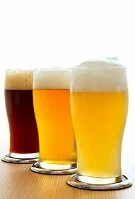Once seated, your host might give a short toast and the guest of honor is expected to reciprocate and give one in return, so try to figure out if you're the guest of honor before the toast. No one else tends to give toasts, however if they do, the typical response before drinking is "Prost."
Before ordering your food, you may notice that everything on the menu is ale carte, even the bread on the table has a charge and fast service restaurants may sell ketchup packets. After the food arrives, say "guten appetit" before beginning. Hold your knife in the right hand and the fork in the left, but if possible always cut your foods with your fork, it's a compliment to the chef displaying how tender the food is.
Be sure to finish all the food on your plate and to show you're finished, place your fork and knife together at the 5:00 position. If dining at a restaurant, the host is expected to pay for everyone, but many times the host may excuse him or herself to pay at the bar or cashier station. If you're the host, be prepared to pay the bill in cash since credit cards are rarely accepted in German restaurants, even high-end restaurants. If you dined at a local's house, it is expected that you send a hand-written thank you note the following day.
Also, when eating at a sit down restaurant with a server, you should tip about 10% of the bill. It's best to give the waiter or waitress the money and tell them what you want to pay instead of leaving the tip on the table. In bars a tip of €1 per order is standard.
Drinks

Beers
The Germans rarely drink tap water and this is especially true in restaurants. Both carbonated water and still water are popular so if you prefer one over the other, specify. Coffee and tea are also growing in popularity, with both easily accessible as are other popular international beverages, such as juices, soft drinks, and milk.
The most popular alcoholic beverage in Germany is the one that the country is forever tied to: beer. In fact, many people consider German beer the best in the world. The Germans have a wide variety of styles and types of beer and all are made according to historic brewing restrictions. Wine is also popular in wine-growing areas, particularly the Rhine River valley, which makes some of the best Rieslings in the world. Imported beers and wine are also available, although most people prefer the locally produced beverages. Hard liquors are also widely available in Germany.
Despite a local preference for bottled water, generally speaking, the tap water is safe to drink in Germany, but check with locals for any particular regional differences. Also, many people may have troubles adjusting to the local tap water, as it will most certainly be different from what your system is used to.